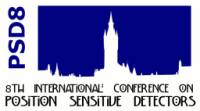Speaker
Ulrich Parzefall
(Fakultaet fuer Physik)
Description
The luminosity upgrade of the LHC to the SLHC will mean a massive increase in radiation levels for the tracking detectors close to the interaction point. The development of ultra-radiation hard silicon detectors is required for the innermost tracking layers. One option for radiation-hard silicon sensors is the 3D technology, where columnar electrodes are etched deep into the silicon bulk. This means a short charge collection distance (counteracting radiation-induced charge trapping), and reduces the depletion voltage compared to planar sensor designs. We have developed and obtained 3D sensors from several sources, and will report on the designs and processing of the sensors. A large number of 3D sensors were studied in probe-station measurements. Several sensors, in particular 3D strip designs, have been connected to LHC-speed readout electronics, and were then tested with an IR-laser system, with a Sr90-beta-source setup and in a test beam at CERN. We will describe the results from these measurements, and draw conclusions on the maturity of the 3D technology as well as the feasibility to use it for SLHC tracking applications.
Author
Ulrich Parzefall
(Fakultaet fuer Physik)

